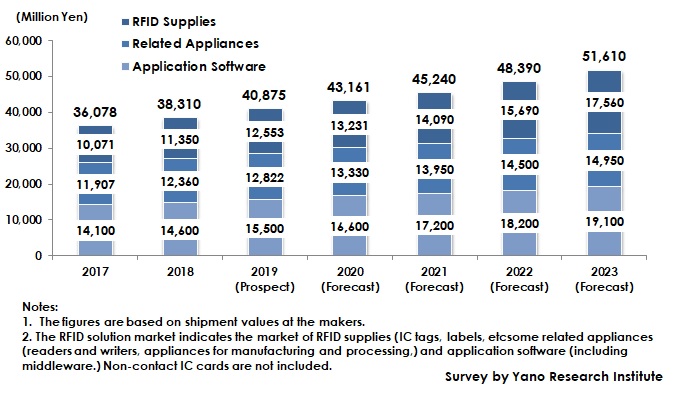No.2229
Global RFID Solution Market: Key Research Findings 2019
Domestic RFID Solution Market in 2018 grew by 6.2% on Y-o-Y Basis to Attain 38,310 Million Yen
Yano Research Institute (the President, Takashi Mizukoshi) has conducted a survey on the global market of RFID solutions and has found out the trends by product segment, the trends of market players, and the future perspectives. This report mainly describes the analyzed results on the domestic market.

Market Overview
RFID (Radio Frequency Identification) is one of the automatic identification technologies expected as a tool for highly intelligence services. It was after the latter half of 1990s that application development of RFID were fully started, at which IC memories improved, the cost reduced, and batteryless progressed. By 1999, the attempt to standardize RFID technologies has started.
The domestic market size of RFID solutions in 2018 grew to 106.2% of the size of the previous year to attain 38,310 million yen. RFID tags have been introduced mainly in the apparel industry, but they are actually used overseas, mainly in China and Southeast Asian areas where production bases for apparel products are located. Therefore, the domestic demand for those tags is still limited.
Although the price of RFID tags largely declined, implementing of RFID solutions requires large initial investment to the readers, writers and application software, making companies, including those in the distribution industry, reluctant to introduce.
Noteworthy Topics
Domestic Market Expects Expansion of High-Function RFID Tags
Both the domestic and overseas demand for RFID is likely to steadily expand, especially those low-price general-purpose ones aimed at the apparel industry, so that introduction of RFID is still limited to the apparel industry. In such a situation, some high-functioned RFID tags, including those that can be attached to metal materials or those insusceptible to water, difficult for general-purpose tags to manage, have been increasingly implemented. In the future, they may respond to the domestic demand as well as the demand by the Japanese companies overseas.
Future Outlook
The domestic RFID solution market size is projected to attain 51,610 million yen by 2023.
In addition to stable demand for RFID tags for apparel industry, the demand for those high-function tags such as those available for metals, those durable to laundry*1, or those for authenticity determination*2 are expected to rise. Therefore, the domestic RFID solution market as a whole is expected to be driven by high-functioned tags.
*1. Wash-proof tags are heat-resistant and cold-tolerance IC tags, durable to washing machines and dryers. Therefore, they are used for loss prevention of valuable clothing and pieces of laundry.
*2. Authenticity determination tags are IC tags equipped with brittle-processed layer. When the label is ripped off, the antenna circuits will be broken and the IC tags will fail to function. Therefore, the tags are used for preventing illegal re-paste and reuse of the label. They are often used for high-class wine bottles and luxury cosmetic packages.
Research Outline
2.Research Object: RFID manufacturers, solution service providers, and industrial groups
3.Research Methogology: Face-to-face research by the expert researchers and literature research
RFID Solution Market
RFID (Radio Frequency Identification) solutions are one of the automatic identification technologies. They automatically identify and track information that is electronically stored in RFID (IC) tags attached to objects by means of non-contact read-and-write technologies through wireless communication. The RFID solution market in this research indicates the market of RFID supplies (IC tags, labels, etc.,) some related appliances (readers and writers, appliances for manufacturing and processing,) and application software (including middleware.) The market size is calculated based on shipment values at the makers. Note that non-contact IC cards represented by Suica, PASMO and Edy are considered to be included in RFID in a broad sense, due to use of the similar non-contact technology, but they are not included in this research.
Published Report
Contact Us
The copyright and all other rights pertaining to this report belong to Yano Research Institute.
Please contact our PR team when quoting the report contents for the purpose other than media coverage.
Depending on the purpose of using our report, we may ask you to present your sentences for confirmation beforehand.